 Return to
Return toAviation Answer-Man
Gateway
 Return to
Return to
Aviation Answer-Man
Gateway
 Return to
Return to
Copyright 2000, 2001, 2002 by Richard Harris
Revised September 2001
Jet Commander
By 1965, Aero Commander had delivered its first Jet Commander, for a price of about a half-million dollars. Over the next few years, up to 8 jets a month would come off the assembly lines. Though the Jet Commander design would eventually be sold off to a string of future owners, it would continue to be a popular aircraft, with over 500 built, sold and flown world-wide by the end of the century.
The Cost of Business: $$$
This was an industry with clear winners and losers. The brutal aviation-industry shakeouts of the early 1930's, and the late 1940's -- in which most light-aircraft companies were wiped out -- had made that fact brutally clear.
The Competition Heats Up
Aero Commander was already facing stiff competition from the Big Three general aviation manfacturers (Cessna, Beech and Piper) over its propellor aircraft lines. And things were looking increasingly challenging in the bizjet market.
And Bill Lear was on the verge of introducing a fast, efficient, sexy, personal jet that would rock the aviation world, and become a household word: Learjet (below, right).
This was no time for a business-aircraft company to be caught short on development money. But banks were loathe to invest in the technical, highly-specialized, and volatile general aviation industry. They were especially reluctant to loan money to a small-plane manufacturer who lagged well behind the "Big Three" (Cessna, Beech and Piper) in longevity, sales and assets.
The Solution:
How then to get access to the investment capital needed to stay in the game? The solution was to merge with another company. By 1965, Aero Commander had arranged to become the Aero Commander Division of the much larger Rockwell-Standard Corp.. With the new ownership providing deeper pockets from which to invest, Aero Commander now had a brighter future. Even the process of getting bank loans would be easier, now that the bankers could see that there was a backer to pay the bills if Aero Commander failed.
But with marriage comes baggage. After its successful acquisition of little Aero-Commander, Rockwell-Standard became even more interested in aviation, and set its sights on something far more ambitious: buying North American Aviation.
North American Aviation
In 1967, Aero Commander's parent company, Rockwell-Standard Corp. began its move on North American Aviation. One major obstacle stood in the way: the Jet Commander (below, left). North American (as noted earlier) was also building a business jet -- the Sabreliner (below, right)-- which was in competition with the JetCommander. Because of anti-monopoly laws, the U.S. government would not approve the merger of the two companies, unless one of the business jet lines was sold off. (This was a time when these two jet planes comprised about half of the models on the newly-developed bizjet market.)
Reluctantly, North American Rockwell sold off the Jet Commander line, to keep the Sabreliner. But the highly-regarded Jet Commander quickly found an eager buyer -- a long, long way away.
Commodore Jet and Beyond...
The government of Israel, whose success in ongoing wars with its Arab neighbors depended heavily on Israeli airpower, had begun creating its own aviation industry, with Israel Aircraft Industries, Ltd. (IAI). The company started out by modifying foreign military aircraft to meet Israel's unique needs, and producing licensed versions of foreign aircraft. But the resources invested in military work for Israel could also be made to pay for themselves by using IAI's factories to build civilian products for export. IAI saw an opportunity in the 1121 design, and bought it, along with all the tooling and parts, and 49 aircraft still not completed, and moved production to Israel.
In 1997, IAI spun off the Jet Commander line to a new company which aviation executive Brian Barents (later president of Learjet) helped them form in partnership with the Pritzker family (who had helped develop Hyatt Hotels and Braniff Airways). The result was Galaxy Aerospace, which was formed around the newly transferred design.
~~~~~~~~~~~~~~
To return to the top of this Jet Commander history, CLICK HERE
The Jet Commander
and its
Offspring
~~~~~~~~~~~
A short history
All Rights Reserved
NOTE: This is a two-part report on the Jet Commander, and the airplanes that evolved from it. In the interest of completeness, Section 1 duplicates the
"Jet Commander" discussion
from the
"
Aero Commander History"
history page.
Section 2, however, discusses the changes that follow Aero Commander's divestiture of the Jet Commander design -- following the Jet Commander family through the Commodore Jet and Westwind series, at Israel Industries International (IAI), and continuing through the Astra, Galaxy, and General Dynamics years.
To read the whole Jet Commander story, read on directly below this paragraph. But if you want to skip ahead to Section 2, CLICK HERE
Section 1:
Beginning with Aero Commander:
The Jet Commander Design Comes to Life.
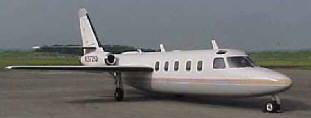 Ironically, Aero Commander produced a pure-jet version before it could come up with a turbo-prop model. In 1963, Aero Commander first flew the Model 1121 Jet Commander, one of the earliest business jets -- or "bizjets." It used a fuselage similar to the Pressurized Grand Commander (though with smaller windows, to allow for the higher pressurization required at high-flying jet altitudes), mated to completely-different, shorter wings (projecting straight out from the mid-section of the fuselage) and twin turbojet engines (mounted in pods on each side of the tailcone).
Ironically, Aero Commander produced a pure-jet version before it could come up with a turbo-prop model. In 1963, Aero Commander first flew the Model 1121 Jet Commander, one of the earliest business jets -- or "bizjets." It used a fuselage similar to the Pressurized Grand Commander (though with smaller windows, to allow for the higher pressurization required at high-flying jet altitudes), mated to completely-different, shorter wings (projecting straight out from the mid-section of the fuselage) and twin turbojet engines (mounted in pods on each side of the tailcone).
 Though it lacked the long range of some competing business jets, the Jet Commander was popular with pilots for its superior handling characterstics, and popular with passengers for its interior room and spectacular view (the entire cabin was forward of the wing).
Though it lacked the long range of some competing business jets, the Jet Commander was popular with pilots for its superior handling characterstics, and popular with passengers for its interior room and spectacular view (the entire cabin was forward of the wing). Just buying engines for aircraft on the assembly line required millions of dollars. And instruments and radios cost money, too, as did all the raw materials, and even the factory facilities themselves. Finally, payroll for hundreds, even thousands, of workers had to be met, while the airplanes slowly took shape on the assembly line.
Just buying engines for aircraft on the assembly line required millions of dollars. And instruments and radios cost money, too, as did all the raw materials, and even the factory facilities themselves. Finally, payroll for hundreds, even thousands, of workers had to be met, while the airplanes slowly took shape on the assembly line.
 While a company could finance a steady, continuous production rate from current sales, it could not finance an expansion -- in product lines or production volume -- that way. The sales would come too late. The highly competitive, high-dollar business aircraft market waited for no one, and the first company to the market with a new product, or the first company to reduce costs (and prices) through mass production, quickly became a dominator in the market -- and would then begin to take away the sales of other aircraft makers.
While a company could finance a steady, continuous production rate from current sales, it could not finance an expansion -- in product lines or production volume -- that way. The sales would come too late. The highly competitive, high-dollar business aircraft market waited for no one, and the first company to the market with a new product, or the first company to reduce costs (and prices) through mass production, quickly became a dominator in the market -- and would then begin to take away the sales of other aircraft makers.
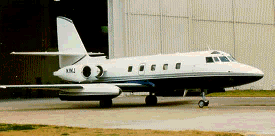 In the business-jet market, four companies had beaten the Jet Commander to market. On the high end, two major aerospace companies were closing in from above: Lockheed (famous for military aircraft and commercial airliners) with their JetStar (left), and North American Aviation (a leading producer of military jets) with its Sabreliner (more on the Sabreliner coming up; for official history from Boeing, who acquired North American in the 1990's, click here).
In the business-jet market, four companies had beaten the Jet Commander to market. On the high end, two major aerospace companies were closing in from above: Lockheed (famous for military aircraft and commercial airliners) with their JetStar (left), and North American Aviation (a leading producer of military jets) with its Sabreliner (more on the Sabreliner coming up; for official history from Boeing, who acquired North American in the 1990's, click here).
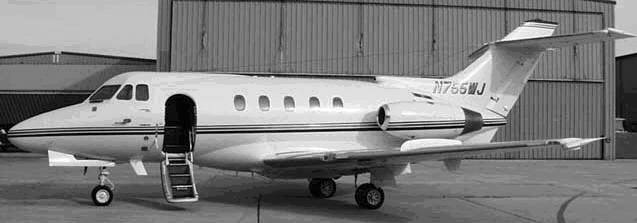 Overseas, Britain's deHavilland had introduced the DH-125 business jet (left) -- soon acquired by Hawker-Siddley as the HS-125. And not to be outdone, the French had produced a 4-6 seat mini-bizjet, the Moraine Saulnier MS.760 Paris Jet Top business-aircraft competitor Beech Aircraft had already introduced the Paris Jet briefly in the U.S., and was soon to team with Hawker Siddley to sell the HS-125 in the U.S. (as the Beech-Hawker BH-125).
Overseas, Britain's deHavilland had introduced the DH-125 business jet (left) -- soon acquired by Hawker-Siddley as the HS-125. And not to be outdone, the French had produced a 4-6 seat mini-bizjet, the Moraine Saulnier MS.760 Paris Jet Top business-aircraft competitor Beech Aircraft had already introduced the Paris Jet briefly in the U.S., and was soon to team with Hawker Siddley to sell the HS-125 in the U.S. (as the Beech-Hawker BH-125).
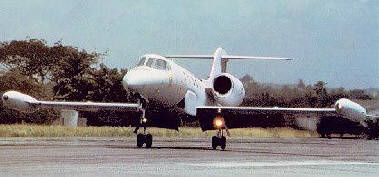
Rockwell Acquires Aero Commander.
The Problem:
Rockwell Acquires North American.
 At the same time, Rockwell-Standard, a company mired in the aging industrial technology of its old product line of mechanical parts, tools and industrial machinery, could invest its old wealth in a booming new technology -- aviation -- that Rockwell was not suited to enter on its own (for a sense of Rockwell's creative limitations, consider that board chairman Willard Rockwell, Sr. had begun his industrial career in 1908). And Aero Commander's highly regarded aircraft -- including its noteworthy progress towards hot new designs -- seemed a smart, long-term investment.
At the same time, Rockwell-Standard, a company mired in the aging industrial technology of its old product line of mechanical parts, tools and industrial machinery, could invest its old wealth in a booming new technology -- aviation -- that Rockwell was not suited to enter on its own (for a sense of Rockwell's creative limitations, consider that board chairman Willard Rockwell, Sr. had begun his industrial career in 1908). And Aero Commander's highly regarded aircraft -- including its noteworthy progress towards hot new designs -- seemed a smart, long-term investment.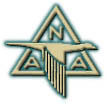 North American Aviation was one of the most famous names in cutting-edge military aviation. North American started tinkering with military aircraft just before World War II. Its first truly successful design was the T-6 Texan trainer (sometimes called the AT-6, SNJ or Harvard). The big, 450-600 horsepower, single-engined, 2-seat T-6 was an advanced-training plane, produced by the thousands, which prepared most of the American and British fighter pilots of World War II to step up into their high-powered fighter planes.
North American Aviation was one of the most famous names in cutting-edge military aviation. North American started tinkering with military aircraft just before World War II. Its first truly successful design was the T-6 Texan trainer (sometimes called the AT-6, SNJ or Harvard). The big, 450-600 horsepower, single-engined, 2-seat T-6 was an advanced-training plane, produced by the thousands, which prepared most of the American and British fighter pilots of World War II to step up into their high-powered fighter planes.
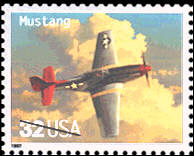 Then came North American's most famous design: With the start of the World War II in Europe, North American began hastily developing the P-51 Mustang fighter, which -- after some initial weaknesses -- eventually became the best fighter aircraft produced by any country in the war. Following that were a string of other successes, including the F-86 Sabrejet fighter which dominated the skies during the Korean War, and the world's first supersonic fighter, the F-100 Super Sabre.
Then came North American's most famous design: With the start of the World War II in Europe, North American began hastily developing the P-51 Mustang fighter, which -- after some initial weaknesses -- eventually became the best fighter aircraft produced by any country in the war. Following that were a string of other successes, including the F-86 Sabrejet fighter which dominated the skies during the Korean War, and the world's first supersonic fighter, the F-100 Super Sabre.

 Which jet to keep and which to let go? The U.S. Air Force, which had bought a number of North American's Sabreliners as the T-39 (see The Sabreliners, below), angrily insisted that the newly-merged companies keep the Sabreliner, so that the Air Force could not only purchase more (under its existing contracts), but so that the Air Force could count on continuing technical support and a continuing production of spare parts -- without which its large investment in T-39's would quickly be lost.
Which jet to keep and which to let go? The U.S. Air Force, which had bought a number of North American's Sabreliners as the T-39 (see The Sabreliners, below), angrily insisted that the newly-merged companies keep the Sabreliner, so that the Air Force could not only purchase more (under its existing contracts), but so that the Air Force could count on continuing technical support and a continuing production of spare parts -- without which its large investment in T-39's would quickly be lost.
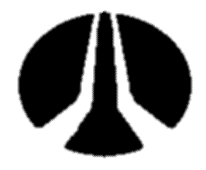 The newly-merged company, North American Rockwell (logo at left), could not afford to anger its main customer, the U.S. Air Force, upon whom it would surely depend for future big-ticket sales of military aircraft. One jet fighter could make the company millions, compared to the "mere" half-million-dollar price of the Jet Commander. A single lost military deal could cost hundreds of millions of dollars. The loss of military business would hurt the new North American Rockwell company much more than the loss of the bizjet trade.
The newly-merged company, North American Rockwell (logo at left), could not afford to anger its main customer, the U.S. Air Force, upon whom it would surely depend for future big-ticket sales of military aircraft. One jet fighter could make the company millions, compared to the "mere" half-million-dollar price of the Jet Commander. A single lost military deal could cost hundreds of millions of dollars. The loss of military business would hurt the new North American Rockwell company much more than the loss of the bizjet trade.
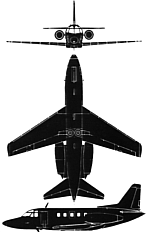 And by keeping the Sabreliner, North American Rockwell could still have some presence in the bizjet market -- as well as the military market. But if they risked alienating the U.S. Air Force, by discarding the Sabreliner to keep the civilian Jet Commander, the Air Force might be much less liklely to do further business with North American. As a result, Rockwell's massive investment in North American -- who only made military aircraft (mostly for the Air Force) -- might become a complete loss.
And by keeping the Sabreliner, North American Rockwell could still have some presence in the bizjet market -- as well as the military market. But if they risked alienating the U.S. Air Force, by discarding the Sabreliner to keep the civilian Jet Commander, the Air Force might be much less liklely to do further business with North American. As a result, Rockwell's massive investment in North American -- who only made military aircraft (mostly for the Air Force) -- might become a complete loss.
Section 2:
Away from Aero Commander:
The Jet Commander Design Stands on its Own.
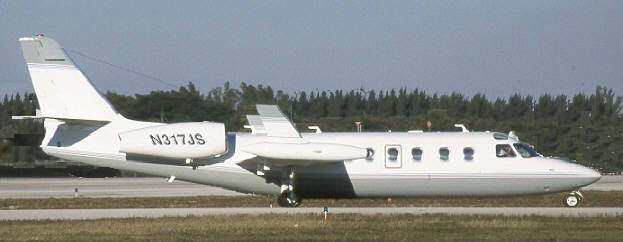 In 1969, IAI re-started production of the plane, renaming it the 1121 Commodore Jet. In 1970, adding tip tanks for greater range, IAI modified it into the popular 1123 Westwind. Later versions have included the popular 1124 Westwind (which introduced modern, efficient Garrett AiResearch TFE-731 turbofan engines, extending range by 10%, and reducing runway length requiremnts), and the 1124B Westwind II (shown here, with up-swept "winglets" added on the tip tanks, to improve high-altitude efficiency, and an improved wing for better performance and range). About 200 of the various Model 1124's were sold.
In 1969, IAI re-started production of the plane, renaming it the 1121 Commodore Jet. In 1970, adding tip tanks for greater range, IAI modified it into the popular 1123 Westwind. Later versions have included the popular 1124 Westwind (which introduced modern, efficient Garrett AiResearch TFE-731 turbofan engines, extending range by 10%, and reducing runway length requiremnts), and the 1124B Westwind II (shown here, with up-swept "winglets" added on the tip tanks, to improve high-altitude efficiency, and an improved wing for better performance and range). About 200 of the various Model 1124's were sold.
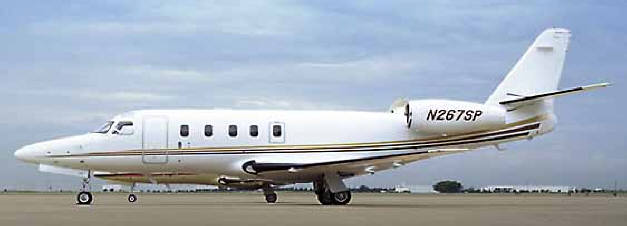 In the mid-1980's, a radical transformation produced the 1125 Astra, which kept only the 1124's original tail and engine nacelles, and switched to a new, low-mounted, swept wing, supporting a longer, more-tubular fueselage (although the 1121 lineage is still visible). The result was a bigger cabin -- putting the plane in a better position to compete with the stand-up room of bigger jets -- and better performance, paticularly extending range by nearly a thousand miles. About this time, IAI created a marketing company to sell the jet, called Astra Jet Corp.
In the mid-1980's, a radical transformation produced the 1125 Astra, which kept only the 1124's original tail and engine nacelles, and switched to a new, low-mounted, swept wing, supporting a longer, more-tubular fueselage (although the 1121 lineage is still visible). The result was a bigger cabin -- putting the plane in a better position to compete with the stand-up room of bigger jets -- and better performance, paticularly extending range by nearly a thousand miles. About this time, IAI created a marketing company to sell the jet, called Astra Jet Corp.
 The company began design work on the 1126 Galaxy -- a new design, emulating the style of the Astra in an enlarged, longer-range version. The design, owned for a few years by Galaxy Aerospace, Ltd., is now owned by General Dynamics, who have renamed the Astra as the G-100, and the Galaxy as the G-200. A generation after the debut of the Jet Commander, its basic design is still a hot product, and over 400 of the Jet Commanders and their offspring are currently flying around the world, today.
The company began design work on the 1126 Galaxy -- a new design, emulating the style of the Astra in an enlarged, longer-range version. The design, owned for a few years by Galaxy Aerospace, Ltd., is now owned by General Dynamics, who have renamed the Astra as the G-100, and the Galaxy as the G-200. A generation after the debut of the Jet Commander, its basic design is still a hot product, and over 400 of the Jet Commanders and their offspring are currently flying around the world, today.
 Return to
Return to
Aero Commander
history page
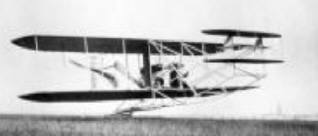 Return to
Return to
Aviation History & Industry
main information page
 Return to
Return to
Aviation Answer-Man
Gateway